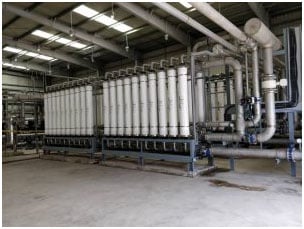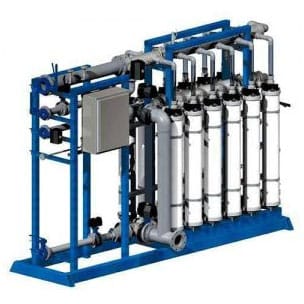MEMBRANE TDS REDUCTION/INDUSTRIAL RO
Membrane based TDS reduction process is used to treat the varied wastes including sewage, organic and inorganic matter and water soluble oil wastes from the manufacturing industries and metal industries. There are numerous membrane technologies available which filter out different particle sizes such as Multi Filtration (MF), Ultrafiltration (UF), Nano filtration (NF), Reverse Osmosis (RO), and Forward Osmosis (FO). Generally UF, NF, and RO are most used in water treatment process.
| Type of process | Pore size |
| Ultra-filtration (UF) | 0.01 to 0.1 micron |
| Nano-filtration (NF) | 0.001 to 0.01 micron |
| Reverse Osmosis (RO) | 0.0001 to 0.001 micron |
Ultra-filtration (UF)
- Ultrafiltration (UF) membranes reject particles such as silica, viruses, endotoxins, proteins, plastics and smog/fumes such as ZnO. Due to the decrease in pore size, the osmotic pressure required is higher than that of MF
- Ultrafiltration is considered as a pre-treatment to RO system this will reduce scaling and fouling of RO system
- Operation of UF system will be automatic and PLC based. Permeate from UF will be collected into the treated water tank. Further the treated water will be disinfected by Sodium Hypochlorite solution

Nano filtration(NF)
- Ultrafiltration (UF) membranes reject particles such as silica, viruses, endotoxins, proteins, plastics and smog/fumes such as ZnO. Due to the decrease in pore size, the osmotic pressure required is higher than that of MF
- Ultrafiltration is considered as a pre-treatment to RO system this will reduce scaling and fouling of RO system
- Operation of UF system will be automatic and PLC based. Permeate from UF will be collected into the treated water tank. Further the treated water will be disinfected by Sodium Hypochlorite solution

Reverse Osmosis (RO)
Reverse osmosis (RO) is a water treatment process in which water is forced through a semi-permeable membrane that has very small holes or “pores”. Clean water passes through and impurities that are too big to pass through the membrane are left behind and flushed away.
Reverse osmosis systems purify water by forcing pressurized water through a very fine, plastic membrane. If the raw water being treated comes from a well or another private source, disinfection and pre-filters (to remove chlorine and/or particulates/sediment) may be needed in advance of the RO unit to remove contaminants that can foul or damage the membrane. Characteristics of the membranes of reverse osmosis must be such that it is permeable to water, highly impermeable to solutes, and can withstand high operating pressures. Scaling and fouling by contaminants in the feed water must not affect RO membrane. There are three major types of reverse osmosis membranes:-
- Cellulosic
- Fully aromatic polyamide
- Thin film composite
Process of RO system
- During the initial filtration stage of Industrial RO, tap water or well water (pressurized by a booster pump) is passed through a particle filter (a pre-filter) that removes silt, sediment, sand, and clay particles that might clog the R/O membrane
- The water is then forced through an activated carbon filter that traps minerals and contaminants such as chromium, mercury, copper, chloramine and pesticides. It also removes chlorine, which is important, as chlorine will shorten the life of the membrane
- Water is transferred under pressure into the R/O module, allowing only clean water to pass through the small pores in the membrane. Impurities unable to pass through the membrane are left behind and flushed down the drain
- Treated water is passed through an activated carbon filter to improve the water’s taste and smell
